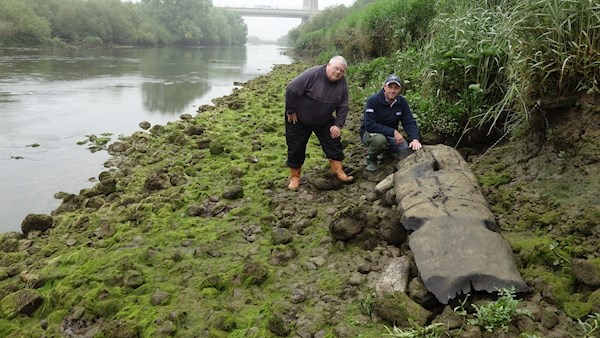River Boyne discovery turns out to be 5,000-year-old longboat
Fri 23 Nov 2018, 23:28:49

Remains found in the River Boyne at Kildare in 2016 are that of a 5,000-year-old longboat, it has been revealed.
Minster for Culture, Heritage and the Gaeltacht, Josepha Madigan, announced the discovery this morning.
Scientific dating confirmed the remains, which were found close to the Brú na Bóinne World Heritage Site, and it dates to the Neolithic period.
The longboat's remains consist of a 3m length of wood which would have formed the base of the boat.
It is estimated that the logboat was originally more than 4m long, shaped out of the trunk of an oak tree using stone axes.
A wood sample was recently radiocarbon dated to between 3,300-2,900BC, which coincides with the period of the construction of the great passage tomb
complexes of Knowth, Dowth and Newgrange.
complexes of Knowth, Dowth and Newgrange.
It is the first boat in River Boyne to date to the Neolithic period and is one of 11 discovered in the stretch of water.
The longboat was originally discovered in June 2016 by four local anglers who reported it to the heritage authorities.
Ms Madigan said: "I want to sincerely thank all involved for reporting this discovery so quickly, which has allowed for its care and ongoing conservation and for this exciting new scientific date to be obtained.
"This new knowledge adds to the wonderful archaeological discoveries made this summer across Brú na Bóinne and enhances our understanding of the people within this special landscape, so dominated by the great River Boyne which would have played such a central part in their lives.
No Comments For This Post, Be first to write a Comment.
Most viewed from International
Most viewed from World
AIMIM News
Latest Urdu News
Most Viewed
May 26, 2020
Do you think Canada-India relations will improve under New PM Mark Carney?
Latest Videos View All
Like Us
Home
About Us
Advertise With Us
All Polls
Epaper Archives
Privacy Policy
Contact Us
Download Etemaad App
© 2025 Etemaad Daily News, All Rights Reserved.

.jpg)






.jpg)
.jpg)


.jpg)
.jpg)
.jpg)
.jpg)
.jpg)
.jpg)
























